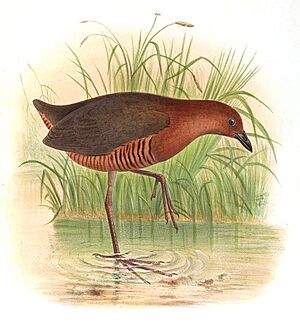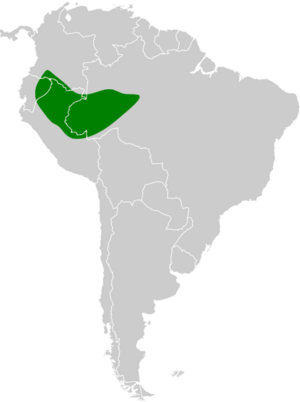Black-banded crake facts for kids
Quick facts for kids Black-banded crake |
|
|---|---|
 |
|
| Conservation status | |
| Scientific classification | |
| Genus: |
Laterallus
|
| Species: |
fasciatus
|
 |
|
| Synonyms | |
|
|
The black-banded crake (Laterallus fasciatus) is a small, shy bird. It is a type of rail, which are birds often found near water or in dense plants. You can find this bird in parts of South America, including Brazil, Colombia, Ecuador, and Peru.
Contents
About the Black-banded Crake
How Scientists Name Animals
Scientists like to group animals together based on how they are related. This is called taxonomy. For the black-banded crake, different groups of scientists have slightly different ideas about which larger group, or genus, it belongs to. Some think it belongs to Laterallus, others to Porzana, and some to Anurolimnas.
Even with these different ideas, everyone agrees on one thing: the black-banded crake is a unique species. This means it's the only one of its kind in its specific group.
What Does It Look Like?
The black-banded crake is a small bird, about 17 to 20 centimeters (7 to 8 inches) long. Both male and female birds look the same.
They have a dark bill that can be blackish. Their head, throat, and chest are a reddish-brown color. Their back, rump, and wings are a deep olive-brown. The inner flight feathers have a slight reddish tint.
One of their most noticeable features is their belly. It's a cinnamon-reddish color with strong black stripes. Their legs and feet are a bright coral red, which really stands out! Young birds look similar but have lighter heads and chests. Their upper parts are more chestnut-brown, and the stripes on their belly are olive-brown.
Where Does It Live?
The black-banded crake lives in the western part of the Amazon Basin. This area stretches from southeastern Colombia, south through eastern Ecuador, and into south-central Peru and western Brazil.
These birds love humid places with lots of thick plants. They often live in secondary forest, which is a forest that has grown back after being cut down. They especially like old farm fields that have become overgrown. They also enjoy thickets of Heliconia plants and Cecropia trees found on river islands. You'll mostly find them below 600 meters (2,000 feet) in elevation, but sometimes they can be found as high as 1,100 meters (3,600 feet) in Ecuador.
Black-banded Crake Behavior
Staying in One Place
The black-banded crake is a "resident" bird. This means it stays in the same area all year round and does not migrate to other places.
What Do They Eat?
This crake looks for food on damp ground where there's lots of dense plant cover. It searches for tasty treats in the fallen leaves. Scientists haven't fully documented their diet, but they believe these birds eat small bugs and seeds.
Building a Home
Not much is known about how black-banded crakes raise their young. They are very protective of their territory, which can be about 2 hectares (5 acres) in size. They build a dome-shaped nest out of grass, with an entrance on the side. One nest was found on a fallen tree branch about 2 meters (6.5 feet) above the ground.
Their Special Song
The black-banded crake has a unique song. One expert described it as a "rubbery, musical trill." It sounds deeper and more bubbly than the songs of other crakes in the Laterallus group. The female bird sings a shorter version of this song compared to the male.
Conservation Status
The IUCN (International Union for Conservation of Nature) has assessed the black-banded crake as a species of "Least Concern." This means that, for now, it is not considered to be in danger of disappearing.
Even though it lives across a large area, scientists don't know exactly how many black-banded crakes there are or if their numbers are changing. No immediate threats to the species have been found. In some areas, like Ecuador, they are described as "rare to locally fairly common." In Peru, they are "rare but widespread." It's even thought that they might benefit from some human activity, like small garden plots, because they like the edges of these disturbed areas.


